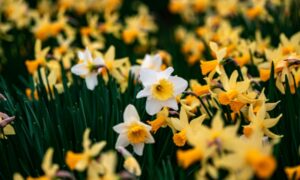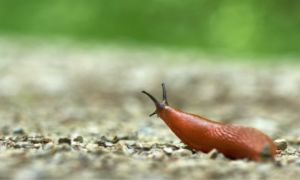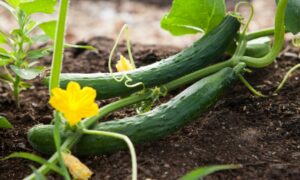We independently research, review, and recommend the best products. If you buy something through our links, we may earn a commission. Learn more.
There’s nothing quite like getting things going in the garden during the month of February. The chill of winter is starting to thaw, and the promise of spring is just around the corner. If you’re anything like me, you’ll start thinking about adding a burst of colour to your outdoor space with a selection of carefully chosen blooms.
In this article, I’ll offer up 8 of my favourite February plants that I absolutely love seeing spring to life. If you’re just starting out or are unsure how to get the most from your garden, hopefully you find my extra care tips and planting advice helpful. So, grab your trowel and let’s get started.
Contents
Snowdrop

This delicate flower is one of the first to bloom in the garden, boasting white petals and green foliage that always signals a palpable change in the seasons. The snowdrop is perfect for planting under trees and shrubs—but if you’ve got a wooded area, I’d encourage you to let them run riot for the ultimate serene setting. Their sweet fragrance is unmistakable, and always brings a smile to my face.
I love planting snowdrops on mass, creating a sea of white flowers that quilt my garden. They also work well when naturalised in grass, where their nodding flowers peek through the blades. And, best of all, snowdrops multiply yearly, bringing joy every time the mercury rises.
Snowdrop care tips: When planting, choose a spot that has well-draining soil and gets at least six hours of sunlight a day. Snowdrops are fussy about soil type, so be sure to choose somewhere that is not too alkaline. To keep them healthy, water regularly in the first growing season, mulch around the base of the plant, and divide the clumps every few years.
Winter Jasmine

This cheerful yellow flower is another early bloomer, bringing a much-needed burst of colour to the garden in the depths of winter. Winter Jasmine is a versatile plant, happy in both sun and shade, and is perfect for planting in walls, fences, and even in containers on a sunny patio. Its delicate but sweet fragrance only adds to its charm. I often plant winter jasmine near my kitchen window, so I can enjoy its calming smell as I prepare meals or do the dishes.
Winter Jasmine care tips: When planting, choose a spot that is well-drained and gets at least six hours of sunlight a day. Winter jasmine is hardy and not particularly fussy about soil type, but it still prefers slightly acidic soils. To keep your plant healthy, water regularly in the first growing season, mulch around the base of the plant, and prune it back to control growth (which is certainly likes!).
Hellebore

Now we come to one of my absolute favourites for the winter garden. If you’re unfamiliar with hellebores, they have beautiful, long-lasting blooms in shades of pink, white, green, and even black. They are also highly adaptable, thriving in both sun and shade, making great additions to borders, rock gardens, or woodland areas.
I particularly love the way the blooms nod down towards the ground, as if bowing in reverence to Mother Nature’s beauty. If you’re a novice gardener, you can’t go wrong with hellebores as they’re hardy perennials that are super easy to care for.
Hellebore care tips: Plant them in well-drained soil that’s rich in organic matter and gets partial to full shade. I recommend watering them regularly during dry spells, then mulch in the spring to help retain soil moisture.
Primrose

Everyone’s heard of primroses. They’re a classic choice for the winter garden, with their cheerful and vibrant blooms ranging from yellow to pink, red, and purple. These hardy perennials are perfect for planting in rock gardens—giving your space a delicate, oriental touch in spring.
I’ve also played around with planting primroses in woodland areas and the front of borders, both of which had stunning results. You should try planting them in large drifts, creating a sea of colour in a similar fashion to snowdrops, especially if you’ve got the space.
Primrose care tips: This plant prefers a cool and moist environment, so it’s really important you find a spot that’s fairly well-shaded. They also love soil that’s rich in organic matter, so adding compost or well-rotted manure when planting is advised.
Winter Aconite

If your borders are a little bare, you’ll love this cheerful little plant. Its yellow cup-shaped flowers and deep green ruff make it the perfect pick-me-up on a cold, grey day. I love planting winter aconites near the front of a border or along a pathway, where they can be appreciated up close. But they’re also great for naturalising in lawns or under trees. If you own a cottage or want an informal garden, you’ll really appreciate how winter aconite gently flowers before the canopies of deciduous trees come into leaf.
Winter Aconite care tips: This plant comes from the buttercup family, so it prefers a neutral-to-slightly acidic soil pH and a decent amount of sunlight. I always mulch around the bulbs to help retain moisture, remove spent blooms regularly, and divide the clumps every few years. You could sow in pots in a cold frame or separate tubers in late spring.
Witch Hazel

If you fancy a plant that will stop your friends in their tracks, plump for witch hazel. It’s so unusual with its spidery blooms, shining in shades of yellow, orange, and red—colours you might expect to see on an exotic beach. And as for the smell…these delicate, alien-like plants produce the most stunning spicy fragrant.
I recommend choosing witch hazel if you’ve got a small garden, as it can be trained as a compact, multi-stemmed shrub or even as a small tree. Although slow growing, they do like to spread! I like to plant witch hazel near a window or seating area, where my guests can wax lyrical over its punchy smell.
Witch Hazel care tips: I tend to grow witch hazel from small round tubers as sometimes they are hard to establish, but you can plant them in the green. To keep it healthy, water regularly in the first growing season and give it a decent mulch around the base.
Mahonia

Want a real workhorse for your winter garden? Mahonia has upright, evergreen foliage and yellow spiking flowers that add structure and intrigue when other plants are dormant. The best part is, once its blossoms have died down, you’ll get juicy purplish berries come autumn! Mahonia is a great choice for shade gardens, as it thrives in dark corners or areas shaded by property.
In my own garden, I love to plant Mahonia near the edge of a mixed border, where its architectural form is appreciated in contrast to softer, more billowy plants. Of course, its fragrant yellow blooms are a real bonus, providing a burst of colour on low ground. I also use Mahonia at the back of borders.
Mahonia care tips: To care for mahonia, you’ll want to water it regularly and mulch in the spring to help retain soil moisture. If your mahonias grow tall at the back of borders and become bare around the base (boy that’s a lot of ‘b’s’!), I recommend cutting back the stems to about half a foot from the ground when it begins to warm.
Agapanthus

This dramatic perennial is a rock star, singing proudly with large, round clusters of trumpet-shaped flowers on tall stems that can reach up to 4 feet. In my experience, agapanthus is a very low-maintenance plant that is best bedded towards the end of February up to April.
The flowers arrive in various colours, including blue, white, and purple—but the former is the most common. One of the great things about agapanthus is its versatility; it can be grown in the ground, in large containers, or even in a mixed border. In my garden, I like to plant agapanthus in large groupings near the back of a border, where its height and showy blooms can be appreciated from a distance. They also make a great focal point when planted in large pots on a patio or deck.
Agapanthus care tips: I recommend planting the evergreen varieties in containers over winter to avoid frostbite, as they’re not always hardy. You can then grow agapanthus in well-drained soil, avoiding shade. Deadheading the spent flowers will encourage new growth.
Preparing your garden in February
Before you start planting any of the beautiful flowers I mentioned above, it’s essential to prepare your garden. Here’s what you need to know:
- Soil Preparation: A well-prepared soil is the key to healthy plants. In February, it’s a good idea to start by removing any weeds or debris from the area you want to plant. Then, dig over the soil to a depth of about 12 inches and incorporate compost or well-rotted manure to improve its structure and fertility. If your soil is heavy clay or sandy, consider adding peat moss to improve its texture.
- Sunlight Exposure: Most of the plants I mentioned earlier prefer full sun to partial shade. So, make sure to choose the right location for each plant based on its specific needs, being mindful of how much sun it receives throughout the day. As the seasons change, so do the direction and amount of sunlight your plants will receive.
- Timing: When it comes to planting, timing is everything. In February, the soil is often still too wet to work with, so be sure to wait until the soil has had a chance to dry out a bit before planting. If you start too early in the season, your plants may struggle to establish themselves, and if you wait too long, they may not have enough time to get established.





